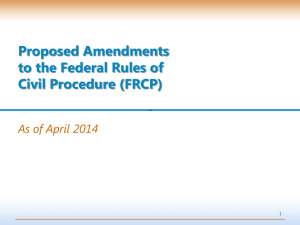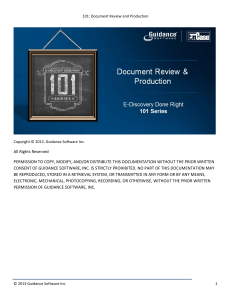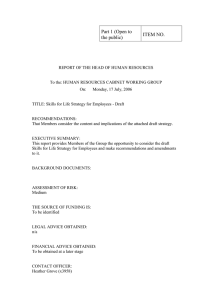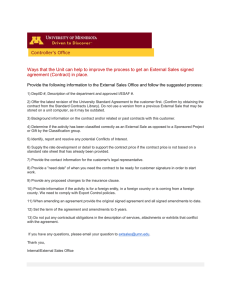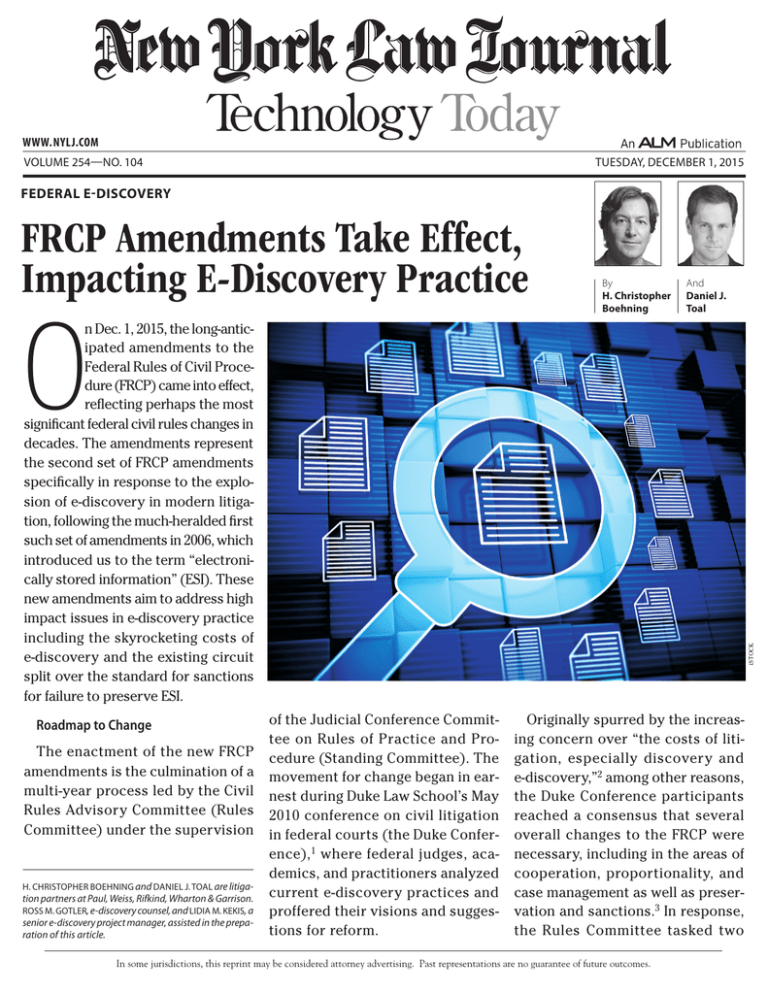
www. NYLJ.com
Tuesday, december 1, 2015
Volume 254—NO. 104
Federal E-Discovery
FRCP Amendments Take Effect,
Impacting E-Discovery Practice
O
By
H. Christopher
Boehning
And
Daniel J.
Toal
Roadmap to Change
The enactment of the new FRCP
amendments is the culmination of a
multi-year process led by the Civil
Rules Advisory Committee (Rules
Committee) under the supervision
H. Christopher Boehning and Daniel J. Toal are litigation partners at Paul, Weiss, Rifkind, Wharton & Garrison.
Ross M. Gotler, e-discovery counsel, and Lidia M. Kekis, a
senior e-discovery project manager, assisted in the preparation of this article.
istock
n Dec. 1, 2015, the long-anticipated amendments to the
Federal Rules of Civil Procedure (FRCP) came into effect,
reflecting perhaps the most
significant federal civil rules changes in
decades. The amendments represent
the second set of FRCP amendments
specifically in response to the explosion of e-discovery in modern litigation, following the much-heralded first
such set of amendments in 2006, which
introduced us to the term “electronically stored information” (ESI). These
new amendments aim to address high
impact issues in e-discovery practice
including the skyrocketing costs of
e-discovery and the existing circuit
split over the standard for sanctions
for failure to preserve ESI.
of the Judicial Conference Committee on Rules of Practice and Procedure (Standing Committee). The
movement for change began in earnest during Duke Law School’s May
2010 conference on civil litigation
in federal courts (the Duke Conference),1 where federal judges, academics, and practitioners analyzed
current e-discovery practices and
proffered their visions and suggestions for reform.
Originally spurred by the increasing concern over “the costs of litigation, especially discovery and
e-discovery,”2 among other reasons,
the Duke Conference participants
reached a consensus that several
overall changes to the FRCP were
necessary, including in the areas of
cooperation, proportionality, and
case management as well as preservation and sanctions.3 In response,
the Rules Committee tasked two
In some jurisdictions, this reprint may be considered attorney advertising. Past representations are no guarantee of future outcomes.
Tuesday, december 1, 2015
subcommittees consisting of judges
and lawyers with drafting and vetting proposals for the amendments.
The Duke Subcommittee (focusing on
overall changes) and the Discovery
Subcommittee (focusing on sanctions
and Rule 37(e)) drafted the proposed
amendments and subsequent revisions, which were eventually adopted
by the Rules Committee (April 11-12,
2013) and the Standing Committee
(June 3, 2013).
On Aug. 15, 2013, the Standing Committee initiated a six-month public
comment period, which resulted
in thousands of responses both at
public hearings and online.4 After
several significant edits in response
to the comments, the updated proposal packet received approval and
additional recommendations from the
Rules Committee (April 10-11, 2014),
the Standing Committee (May 29-30,
2014), and the Judicial Conference
(Sept. 16, 2014).
On April 29, 2015, the U.S. Supreme
Court approved the amendments
and forwarded them to Congress, to
take effect, absent any congressional
action to the contrary, on Dec. 1, 2015.
E-Discovery-Related Amendments
The FRCP amendments impact
Rules 1, 4, 16, 26, 30, 31, 33, 34, 37,
55, and 84 as well as the Committee
Notes and Appendix of Forms.5 Of
these, changes to three rules have
the greatest potential to impact e-discovery—Rules 1, 26, and 37.
Rule 1.
At the onset of the amendment
movement, Rule 1 served as a central focus for additional emphasis
on the concepts of proportionality
and cooperation.6 To the potential
disappointment of some, while
­ roportionality was given increased
p
focus in Rule 26(b), cooperation
was reduced to a mention in the
new Committee Note. Rule 1 was
amended as follows:7
[These rules] should be construed
and, administered, and employed
by the court and the parties to
secure the just, speedy, and inexpensive determination of every
action and proceeding.8
The new Committee Note explains
that the new language aims “to
emphasize that just as the court
should construe and administer
these rules to secure the just, speedy,
and inexpensive determination of
The amendments represent the
second set of FRCP amendments
specifically in response to the
explosion of e-discovery in modern litigation.
every action, so the parties share
the responsibility to employ the
rules in the same way.”9 The Note
further states that “[e]ffective advocacy is consistent with—and indeed
depends upon—cooperative and proportional use of procedure.”10
Rule 26.
A potentially significant change
in the new FRCP amendments is
an increased focus on proportionality in discovery. Rule 26(b)
(1) was amended accordingly: 11
Scope in General. Unless otherwise limited by court order,
the scope of discovery is as
follows: Parties may obtain discovery regarding any nonprivileged matter that is relevant to
any party’s claim or defense and
proportional to the needs of the
case, considering the importance of the issues at stake in
the action, the amount in controversy, the parties’ relative
access to relevant information,
the parties’ resources, the importance of the discovery in resolving the issues, and whether the
burden or expense of the proposed discovery outweighs its
likely benefit. Information within
this scope of discovery need not
be admissible in evidence to be
discoverable. – including the
existence, description, nature,
custody, condition, and location
of any documents or other tangible things and the identity and
location of persons who know
of any discoverable matter. For
good cause, the court may order
discovery of any matter relevant
to the subject matter involved
in the action. Relevant information need not be admissible at
the trial if the discovery appears
reasonably calculated to lead to
the discovery of admissible evidence. All discovery is subject to
the limitations imposed by Rule
26(b)(2)(C).12
With the quantity of ESI booming,
“[p]roportionality continue[d] to be
an object of concern, particularly
with respect to discovery.”13 Rising
e-discovery costs and broadening
document requests, among other
factors, made it seem “clear that
discovery can run beyond what is
reasonable,” thereby effectuating a
need for change.14 As such, “there
was a consensus … on the need for
proportionality”15 with respect to
narrowing the scope of discovery.
This led to changes emphasizing
proportionality within Rule 26(b)(1),
Tuesday, december 1, 2015
including moving, updating, and rearranging the proportionality factors.
The new Committee Note specifies
that returning the proportionality factors from Rule 26(b)(2)(C)(iii) back
to Rule 26(b)(1), where they resided
before 1993, was done to “restore[]
the proportionality factors to their
original place in defining the scope
of discovery. This change reinforces
the Rule 26(g) obligation of the parties to consider these factors in making discovery requests, responses,
or objections.”16 Moreover, the new
text removes the “reasonably calculated” language that “has been used
by some, incorrectly, to define the
scope of discovery.”17
Other changes to Rule 26 include:
• Rule 26(c)(1)(B) adds “the allocation of expenses” for discovery as
a permissible topic for a protective
order.
• Rule 26(d)(2) “is added to allow
a party to deliver Rule 34 requests
to another party more than 21 days
after that party has been served even
though the parties have not yet had
a required Rule 26(f) conference.”18
• Rule 26(f)(3) was “amended in
parallel with Rule 16(b)(3) to add
two items to the discovery plan—
issues about preserving electronically
stored information and court orders
under Evidence Rule 502.”19
Rule 37.
Rule 37(e) required a complete
overhaul to address the “sense of
bewilderment about the scope”20 of
preservation obligations that results
in “inefficient, wasteful, expensive,
and time-consuming information
management and discovery, which
in turn adds to costs and delays in
litigation.”21 Moreover, the “circuits
have developed different approaches to the duty to preserve ESI”22 as
well as to “the degree of culpability
required for various sanctions,”23 as
demonstrated in varying sanctions
decisions.24 This spawned the need to
resolve the circuit split and to have “a
rule establishing uniform standards of
culpability for different sanctions”25
across all jurisdictions.
Despite the “significant support …
for more precise guidance in the rules
on the obligation to preserve information relevant to litigation and the
consequences of failing to do so,”26
drafting new language proved to be
arguably “the most hotly contested
area throughout the public comment
The new FRCP amendments related to e-discovery aim to bring
much-needed clarity and guidance on issues that have had a
significant impact on modern
litigation.
period.” 27 Topics heavily debated
included, among others, remedying
lost ESI, “curative measures” versus
“sanctions,” prejudice, and state of
mind when having lost ESI.”28 Ultimately, the finalized language not
only establishes clear guidelines
on preservation and consequences
for lack thereof, but also hopes to
address concerns regarding escalating e-discovery costs, as “[r]educing the fear of sanctions may reduce
the extent of over-preservation.”29
Rule 37(e) now states:
Failure to Preserve Electronically Stored Information. If electronically stored information that
should have been preserved in
the anticipation or conduct of
litigation is lost because a party
failed to take reasonable steps
to p
­ reserve it, and it cannot be
restored or replaced through additional discovery, the court:
(1) upon finding prejudice to
another party from loss of the
information, may order measures
no greater than necessary to cure
the prejudice; or
(2) only upon finding that the party acted with the intent to deprive
another party of the information’s
use in the litigation may:
(A) presume that the lost information was unfavorable to the party;
(B) instruct the jury that it may
or must presume the information
was unfavorable to the party; or
(C) dismiss the action or enter a
default judgment.30
As explained by the new Committee Note:
[The existing rule] has not adequately addressed the serious
problems resulting from the
continued exponential growth in
the volume of such information.
Federal circuits have established
significantly different standards
for imposing sanctions or curative measures on parties who fail
to preserve electronically stored
information. These developments
have caused litigants to expend
excessive effort and money on
preservation in order to avoid the
risk of severe sanctions if a court
finds they did not do enough.31
The new rule requires an analysis
of whether certain prerequisites have
been met prior to even broaching
the topic of sanctions, specifically,
is it ESI, should the ESI have been
preserved, has ESI been lost, did the
party fail to take reasonable steps
to preserve the lost ESI,32 and is the
lost ESI restorable or replaceable via
Tuesday, december 1, 2015
additional discovery. Only after having satisfied these conditions may a
court consider one of two clearly
defined remedies. Under subsection
(1), upon a finding of prejudice, the
court then may impose curative measures no greater than necessary to
cure the prejudice.33
Under subsection (2), upon a finding of acting with intent to deprive
another party of the ESI, irrespective of prejudice, a court may, upon
its discretion, impose one of three
listed severe sanctions.34 As the Note
explains, restricting severe sanctions
to these circumstances essentially not
only “rejects cases such as Residential Funding Corp. v. DeGeorge Financial Corp., 306 F.3d 99 (2d Cir. 2002),
that authorize the giving of adverseinference instructions on a finding of
negligence or gross negligence,”35 but
also “forecloses reliance on inherent
authority or state law to determine
when certain measures should be
used.”36 As one former judge noted,
under new 37(e), “[n]obody is held to
a standard of perfection; it’s a standard of reasonableness.”37
Conclusion
The new FRCP amendments
related to e-discovery aim to bring
much-needed clarity and guidance
on issues that have had a significant
impact on modern litigation. While
this came from a consensus position
that change was needed, looming
questions cast some doubt as to the
amendments’ long-term success. Will
the increased focus on proportionality succeed in reducing costs related to discovery or fail by attracting
more motion practice on the topic?
Will new Rule 37(e) actually result in
uniformity across the circuits or open
the door for new judicial divergence?
Only time will tell if the amendments
will have their desired effect.
••••••••••••••••
•••••••••••••
1. Various materials, empirical research, and submitted papers from the Duke Conference are available at http://www.
uscourts.gov/rules-policies/records-and-archives-rules-committees/special-projects-rules-committees/2010-civil.
2. Minutes of April 20-21, 2009 Civil Rules Advisory Comm.,
at 30 (lines 1285-1286), http://www.uscourts.gov/file/15091/
download?token=Hxr6Puwp.
3. Report of the Duke Conference Subcommittee of April
10-11, 2014, Agenda Book for April 1, 2014 Civil Rules Advisory Comm., at 79, http://www.uscourts.gov/rules-policies/
archives/agenda-books/advisory-committee-rules-civil-procedure-april-2014; see also, Thomas Y. Allman, “The 2015 Civil
Rules Package As Transmitted to Congress,” June 15, 2015, at
2, http://www.theediscoveryblog.com/wp-content/uploads/2
014/10/2015SummaryofRulesPackage.pdf.
4. See written comments, http://www.regulations.
gov/#!docketDetail;D=USC-RULES-CV-2013-0002.
5. Proposed Amendments to the Federal Rules of Civil
Procedure, http://www.uscourts.gov/rules-policies/pendingrules-amendments.
6. Proportionality and cooperation are concepts often discussed in e-discovery academic circles as being critical to effective and efficient modern litigation. See, e.g., The Sedona
Conference, “The Sedona Conference Cooperation Proclamation,” 10 SEDONA CONF. J. 331 (2009); The Sedona Conference, “The Sedona Conference Commentary on Proportionality in Electronic Discovery,” 11 SEDONA CONF. J. 289 (2010),
14 SEDONA CONF. J. 155 (2013).
7. New rule text is underlined; removed rule text is struck
through.
8. Proposed Amendments to the Federal Rules of Civil
Procedure, at 1 (lines 4-7), http://www.uscourts.gov/rulespolicies/pending-rules-amendments.
9. Fed. R. Civ. P. 1 advisory committee’s note.
10. Id.
11. New rule text is underlined; removed rule text is struck
through.
12. Proposed Amendments to the Federal Rules of Civil
Procedure, at 10-11 (lines 4-30), http://www.uscourts.gov/
rules-policies/pending-rules-amendments.
13. Minutes of Nov. 7-8, 2011 Civil Rules Advisory Comm.,
at 8 (lines 343-344), http://www.uscourts.gov/rules-policies/
archives/meeting-minutes/advisory-committee-rules-civilprocedure-november-2011.
14. Id. at 8 (lines 350-351).
15. Minutes of April 10-11, 2014 Civil Rules Advisory Comm.,
at 5 (lines 189-190), http://www.uscourts.gov/rules-policies/
archives/meeting-minutes/advisory-committee-rules-civilprocedure-april-2014.
16. Fed. R. Civ. P. 26 advisory committee’s note.
17. Id.
18. Id.
19. Id.
20. Report to the Chief Justice of the United States on the
2010 Conference on Civil Litigation, at 8, http://www.uscourts.
gov/rules-policies/records-and-archives-rules-committees/
special-projects-rules-committees/2010-civil.
21. Id.
22. Minutes of April 10-11, 2014 Civil Rules Advisory Comm.,
at 17 (lines 699-700), http://www.uscourts.gov/rules-policies/
archives/meeting-minutes/advisory-committee-rules-civilprocedure-april-2014.
23. Report to the Chief Justice of the United States on the
2010 Conference on Civil Litigation, at 8, http://www.uscourts.
gov/rules-policies/records-and-archives-rules-committees/
special-projects-rules-committees/2010-civil.
24. For example, “[t]he Second Circuit approved sanctions
for negligence or gross negligence … [whereas the] Fifth and
Tenth Circuits … allow adverse-inference instructions only if
there is enough culpability to support an inference that the
lost information was unfavorable to the party who lost it.”
Minutes of April 10-11, 2014 Civil Rules Advisory Comm., at
17 (lines 704-710), http://www.uscourts.gov/rules-policies/
archives/meeting-minutes/advisory-committee-rules-civilprocedure-april-2014.
25. Report to the Chief Justice of the United States on the
2010 Conference on Civil Litigation, at 8, http://www.uscourts.
gov/rules-policies/records-and-archives-rules-committees/
special-projects-rules-committees/2010-civil.
26. Id. at 8.
27. Michele Lange, “FRCP Amendments: The Long and
Winding Road,” April 21, 2014, http://www.theediscoveryblog.com/2014/04/21/frcp-amendments-long-winding-road.
28. See Minutes of April 10-11, 2014 Civil Rules Advisory
Comm., at 18-32, http://www.uscourts.gov/rules-policies/archives/meeting-minutes/advisory-committee-rules-civil-procedure-april-2014; see also Report to the Chief Justice of the
United States on the 2010 Conference on Civil Litigation, at 8,
http://www.uscourts.gov/rules-policies/records-and-archivesrules-committees/special-projects-rules-committees/2010civil.
29. Minutes of Nov. 7-8, 2011 Civil Rules Advisory Comm.,
at 15 (lines 694-695), http://www.uscourts.gov/rules-policies/
archives/meeting-minutes/advisory-committee-rules-civilprocedure-november-2011.
30. Proposed Amendments to the Federal Rules of Civil Procedure, available at http://www.uscourts.gov/rules-policies/
pending-rules-amendments.
31. Fed. R. Civ. P. 37 advisory committee’s note.
32. Acknowledging that the rule “does not call for perfection,” id., the Note provides guidance on evaluating the reasonableness of preservation efforts by listing several factors
for consideration, including proportionality in relation to a
party’s available staffing and resources dedicated to preservation efforts and choice to utilize more cost efficient measures.
33. With respect to curative measures, the Note explains
that the “range of such measures is quite broad if they are
necessary,” id., ranging from ordering additional discovery
from other available sources to more “serious measures … ,
such as forbidding the party that failed to preserve information from putting on certain evidence, permitting the parties
to present evidence and argument to the jury regarding the
loss of information, or giving the jury instructions to assist in
its evaluation of such evidence or argument … ” Id.
34. The Note explains that a court may, for example, allow
“the parties to present evidence to the jury concerning the
loss and likely relevance of information and instructing the
jury that it may consider that evidence, along with all the
other evidence in the case, in making its decision.” Id.
35. Id.
36. Id.
37. “Just Follow the Rules! FRCP amendments could be ediscovery game changer,” July 17, 2015, quoting Hon. John
M. Facciola (Ret.), http://www.metrocorpcounsel.com/articles/32726/just-follow-rules-frcp-amendments-could-be-ediscovery-game-changer.
Reprinted with permission from the December 1, 2015 edition of the NEW YORK
LAW JOURNAL © 2015 ALM Media Properties, LLC. All rights reserved. Further
duplication without permission is prohibited. For information, contact 877-257-3382
or reprints@alm.com. # 070-12-15-01

